Filipinos LOVE to eat. Eating and sharing food is a big part of Filipino culture. It brings people together and builds a sense of community. Rarely will you attend a gathering or celebration in the Philippines where food wasn’t a central component.
In fact, one of the most common greetings in the Philippines (even among strangers) is kain na or kumain ka na? This literally translates to “let’s eat” or “have you eaten?” In some instances, the person being invited to eat isn’t really expected to accept, but it’s considered good manners to offer anyway.
Filipino snacks (aka Pinoy snacks) are a big part of Filipino food culture and this is best exemplified in the light afternoon meal known as merienda. I’ll get to it in more detail below but merienda in the Philippines basically refers to any small meal – both savory and sweet – that’s typically eaten between lunch and dinner.
In this article, I’ll describe some of the most popular Filipino snacks that locals eat for merienda. Kain na!
Save This on Pinterest!
No time to read this article on Filipino snacks? Click on the save button and pin it for later!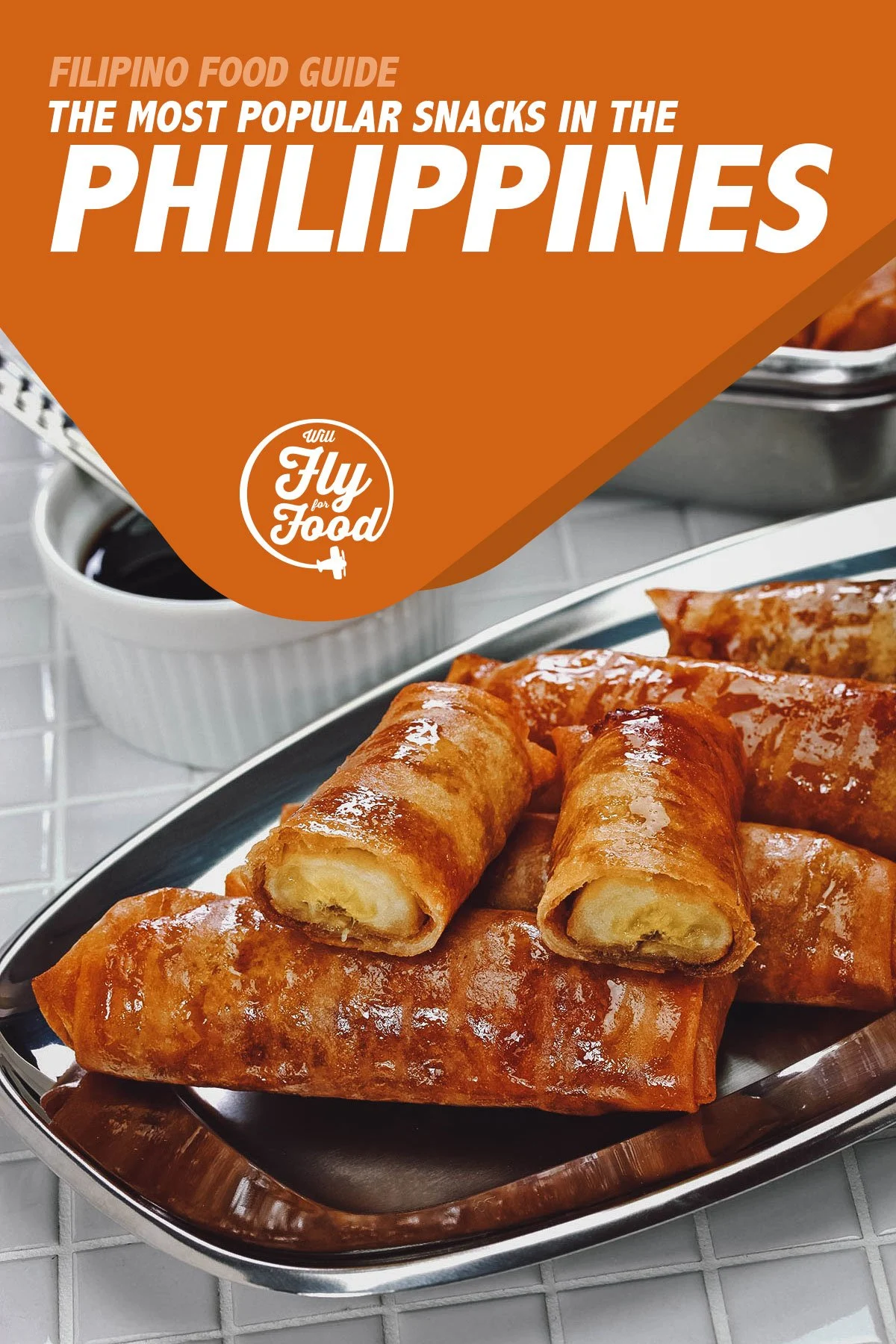
Photo by asimojet
WHAT IS FILIPINO MERIENDA?
The word merienda literally translates to “snack”. It’s a food tradition that’s practiced in different countries like Spain, Portugal, Italy, Argentina, Croatia, Morocco, and Brazil. Being a colony of Spain for over 300 years, it’s clear that Filipinos inherited the tradition from the Spanish though it’s a custom that’s beloved by many cultures around the world.
In Filipino cuisine, merienda is typically enjoyed sometime in the mid-afternoon, around 3 or 4PM. It’s a light snack that can be savory or sweet and is meant to tide you over until dinner.
Most if not all Filipinos who were raised in the Philippines grew up eating merienda. Even Filipinos who grew up in the diaspora are familiar with it because it’s a custom that their parents likely took with them.
Growing up in the Philippines, you just expect to have merienda everyday, even if you’re visiting a friend’s house over the weekend. It’s as common an eating habit in the Philippines as breakfast, lunch, or dinner.
THE BEST FILIPINO SNACKS
There are many different types of Filipino snacks that people enjoy for merienda. It can vary from household to household but these are some of the most common.
1. Turon
There’s no better way to start this article on popular Filipino snacks than with turon, a delicious dish made with thin slices of saba banana (banana cultivar) coated in brown sugar and then deep-fried in lumpia wrapper. It’s a sweet and crunchy Filipino snack that’s also commonly eaten for dessert or sold as street food in the Philippines.
Many Filipinos have fond memories of turon because it’s something we grew up eating. In fact, whenever my US-based brother visits the Philippines, it’s one of the first dishes he looks for. Cheap and easy to make, it’s Filipino comfort food at its most delicious.
Like many people, turon is personally one of my favorite Filipino snacks. Eaten at room temperature, it’s always filled with saba but some versions can be made with a thin sliver of langka (jackfruit) as well. At restaurants, it can be served warm with a scoop of vanilla ice cream for dessert. It’s so delicious.
Speaking of dessert, if you have a fondness for the sweeter things in life, then be sure to check out our article on traditional Filipino desserts.
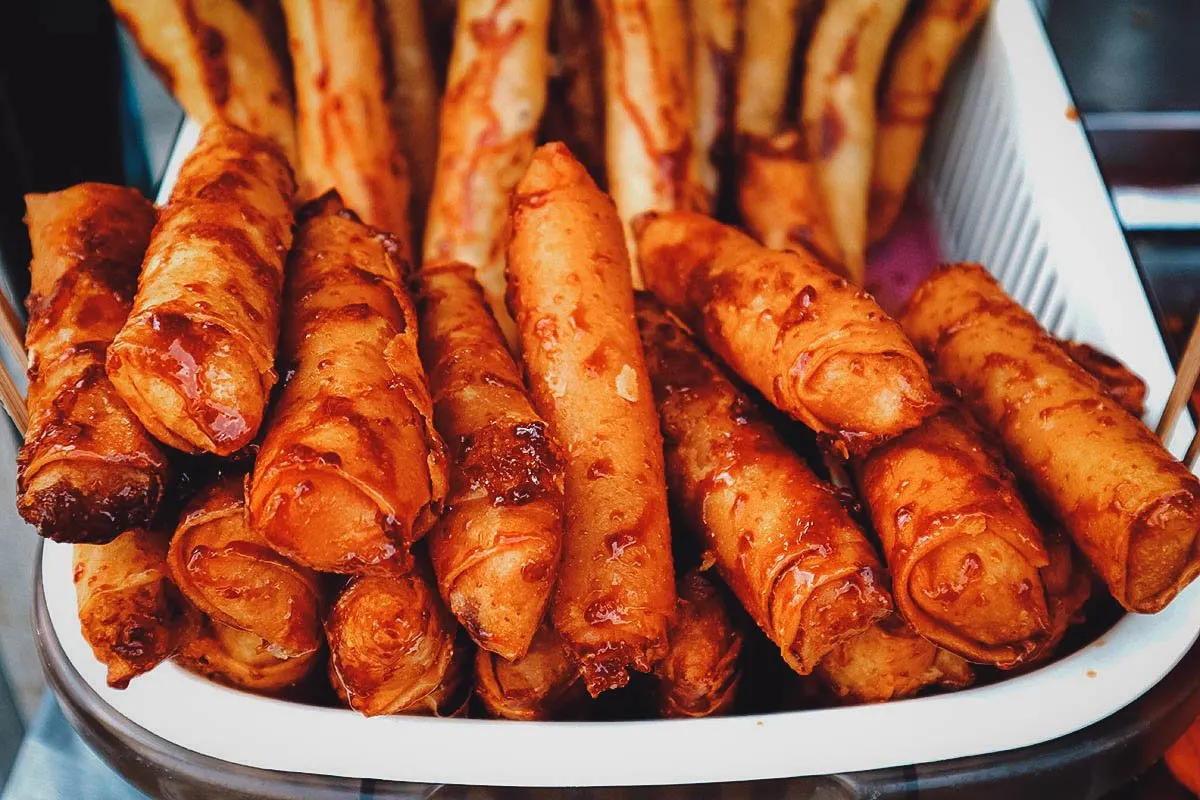
Photo by junpinzon
2. Banana Cue
Turon may be the most popular saba-based Filipino snack but not far behind is banana cue (or banana q). It’s a very similar dish except the saba banana is skewered whole and then coated with brown sugar before being deep-fried.
Both are commonly sold as street food though banana cue may be less frequently made at home. At least that’s how I remember it. It’s even less common to find it on dessert menus at Filipino restaurants.
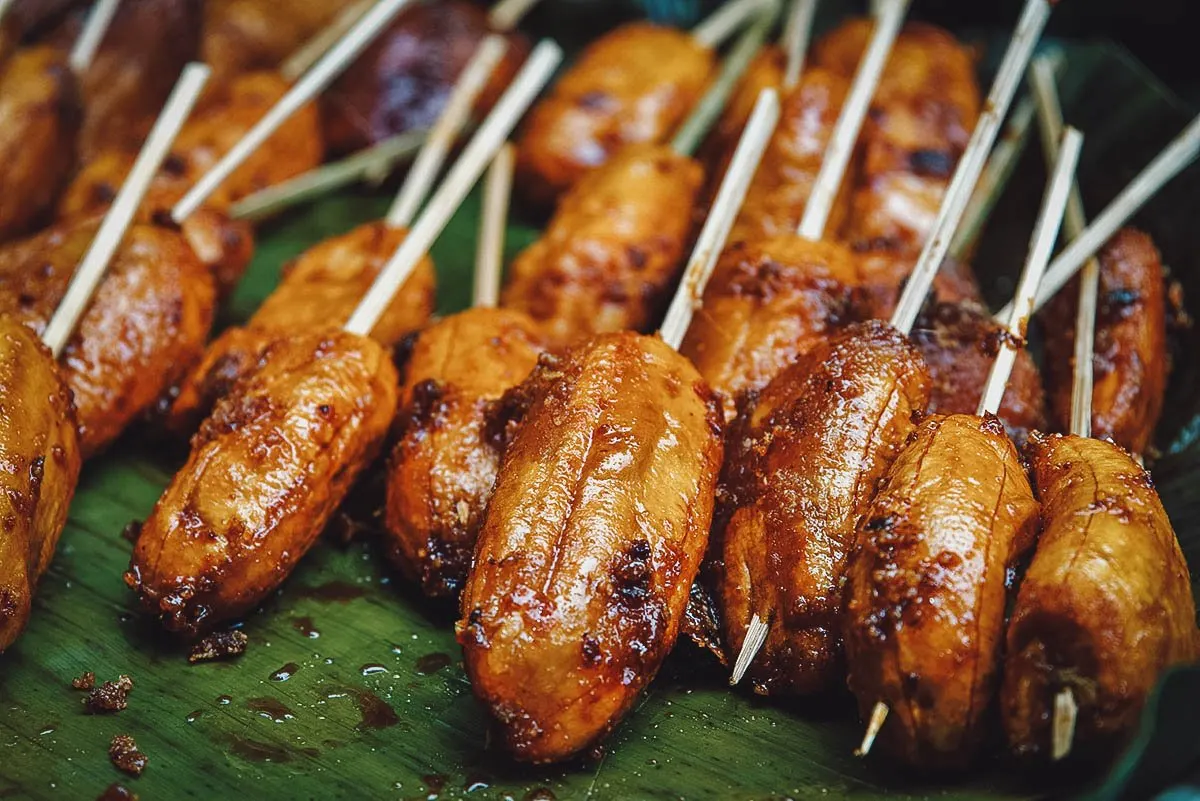
Photo by bugking88
3. Puto / Kutsinta
Puto is one of the most iconic foods in the Philippines. When you think of dishes that best represent Filipino culture and cuisine, puto is one of the first things that comes to mind.
Puto refers to a steamed rice cake made with slightly fermented glutinous rice dough (galapong). Traditionally, they’re made with glutinous rice soaked in coconut milk but more modern versions are often made using glutinous rice flour instead.
The most common versions of puto are small in size, about the diameter of a golf ball, and muffin-shaped. They’re typically plain white but they can come in different colors as well depending on what other ingredients they’re made with like ube, pandan, or queso (cheese).
Pictured below is a basket of puto enriched with cheese. Note the thin sliver of cheese on top. Not all puto is made with that sliver of cheese.
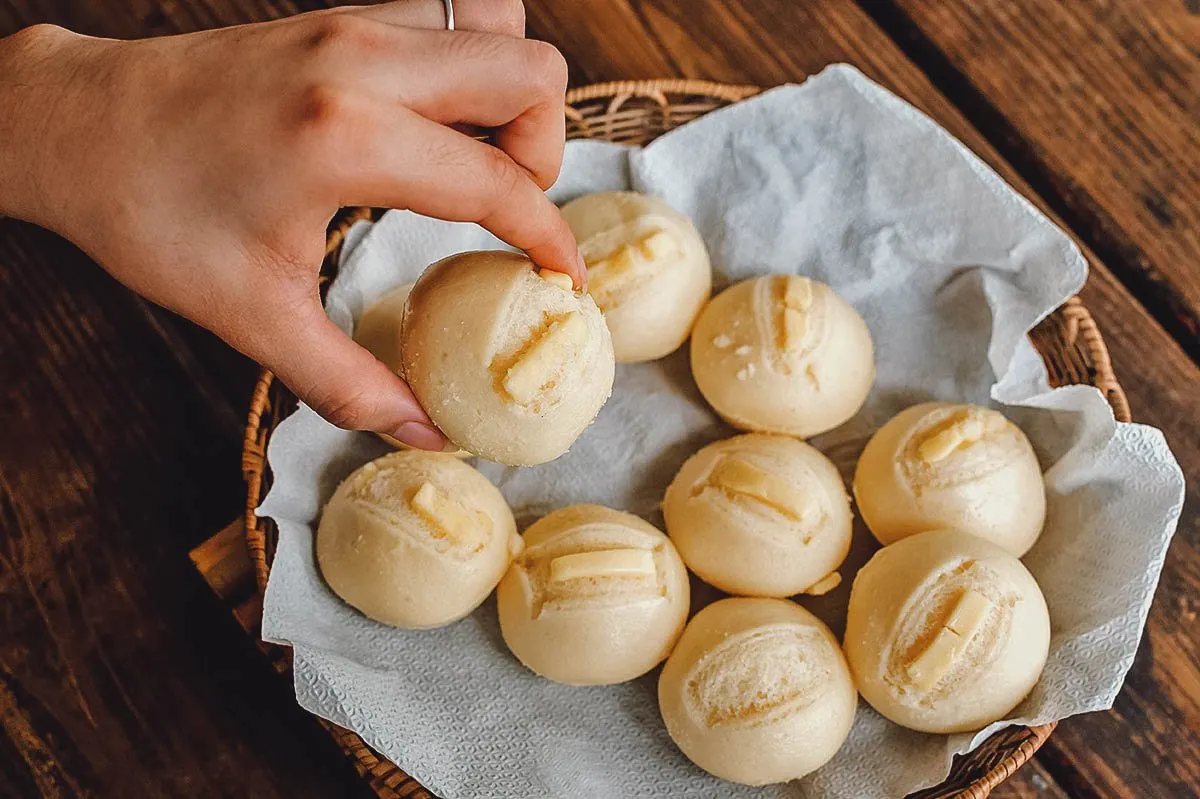
Photo by MikeEdwards
Bite-sized puto is the most common but it can be made in other sizes as well. The version of putong puti (white puto) pictured below is palm-sized and individually wrapped in banana leaves.
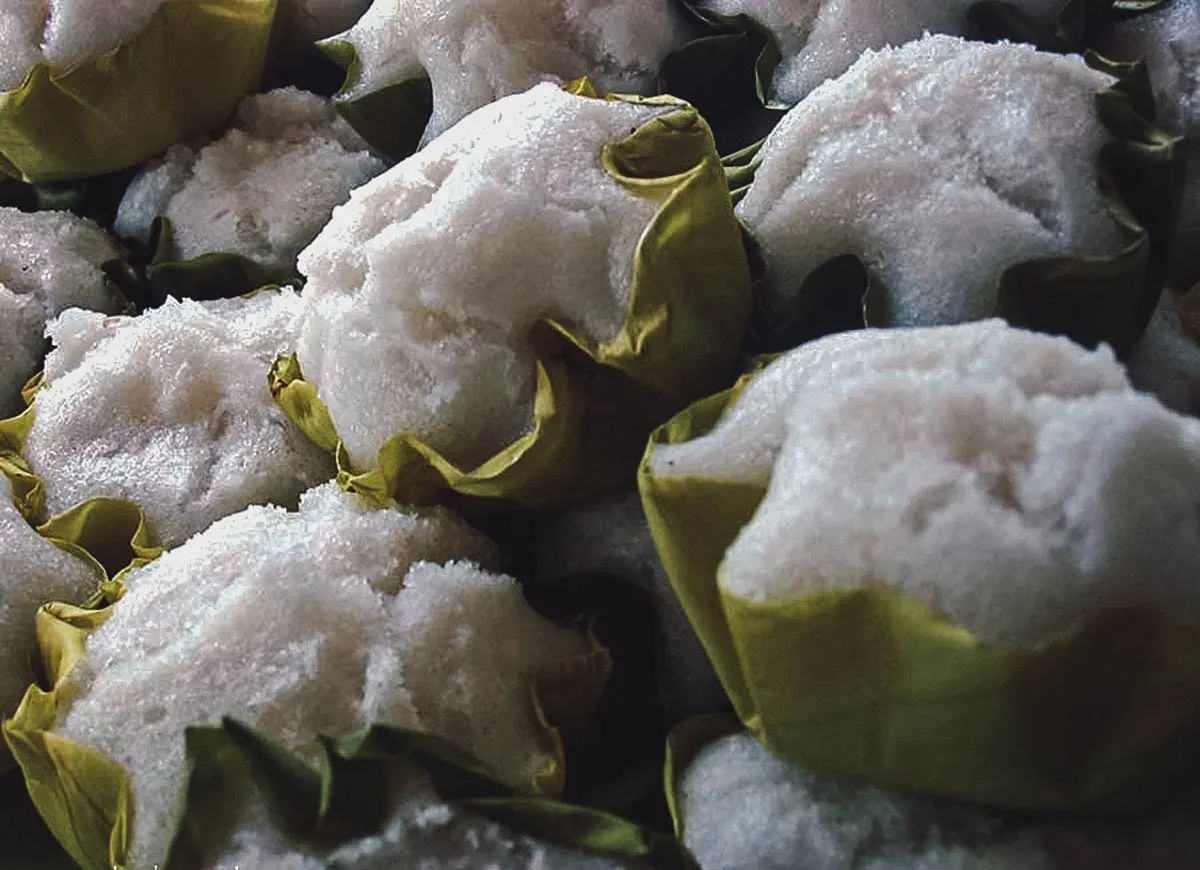
Photo by raksyBH
Puto can also be made into larger sizes, about the same diameter as an average cake or pie. These larger versions of puto are meant for sharing. They’re sliced into wedges and served with grated coconut.
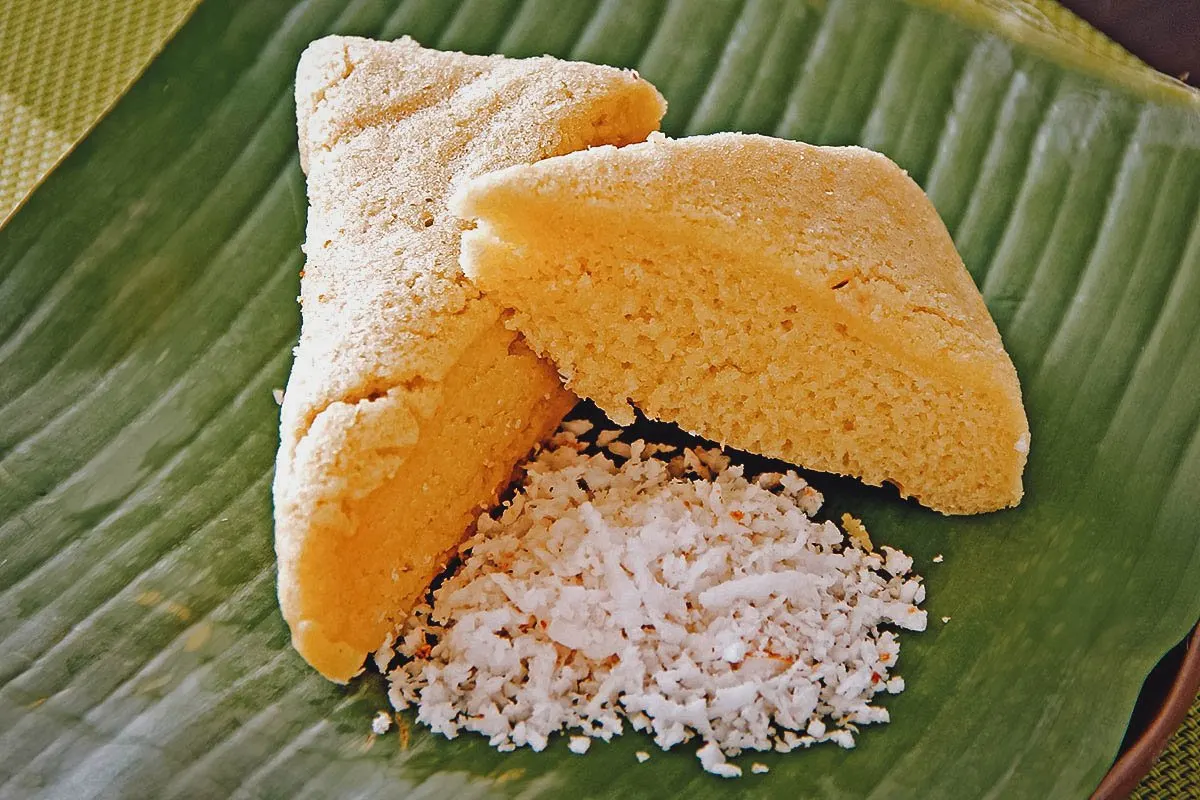
Photo by inotm5
What you’re looking at below is kutsinta, a variation of puto made with lye, annatto (achuete) seeds, and brown sugar (instead of white sugar). Lye gives kutsinta a much stickier and chewier texture while the annatto gives the rice cake its signature deep orange color.
The classic white version of puto is very often sold with kutsinta. Whenever my mom would bring home puto, they would always come with a separate packet of kutsinta. I like them both a lot but kutsinta has always been one of my favorite Filipino snacks.
Sticky, chewy, and a little sweet, kutsinta is absolutely delicious, especially when topped with grated coconut. Like puto, it can be enjoyed for dessert but it’s more commonly consumed as a mid-day snack.
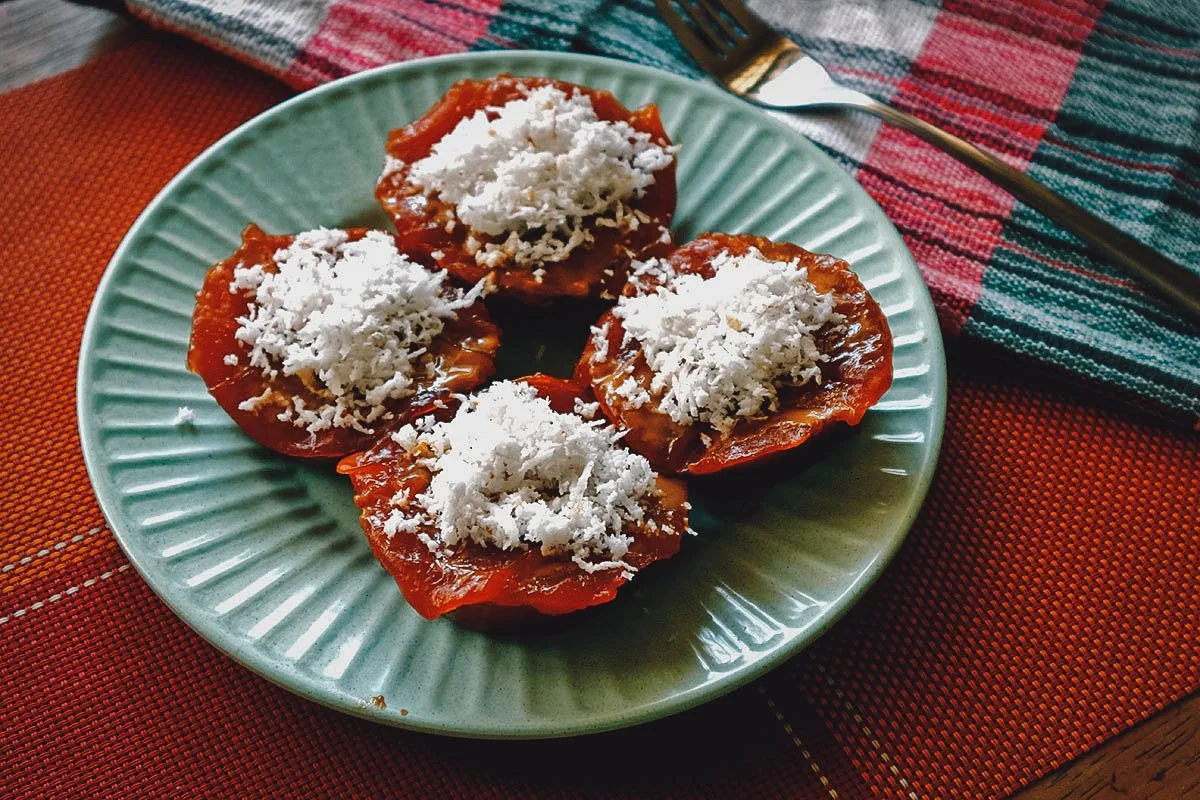
Photo by junpinzon
4. Suman
Like puto, suman is an iconic Filipino snack that’s one of the most culturally representative dishes in Filipino cuisine. It’s made with glutinous rice cooked in coconut milk which is then wrapped in banana leaves before steaming.
Suman is one of the most beloved Filipino snacks but it’s also commonly eaten as breakfast food. Very sticky in texture, it’s typically served warm with a sprinkling of sugar on top or drizzled with latik, a type of caramelized syrup made with coconut cream.
The most common version of suman is cigar-shaped (pictured below) but it can be made in different shapes and varieties as well.
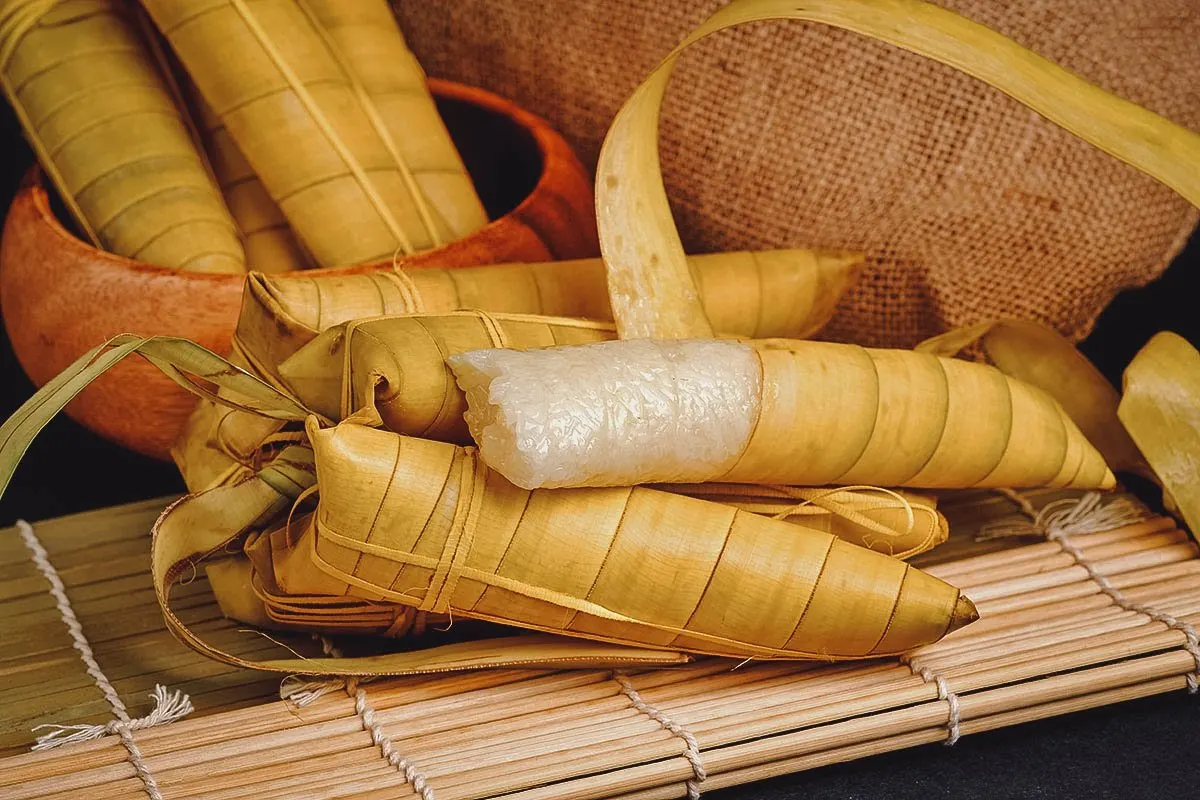
Photo by hendraxu
5. Mangga’t Bagoong
Because of our love for fried foods and all things sweet, I’ll admit that Filipino snacks aren’t the healthiest. If you want to snack on something that’s healthier and guilt-free, then you may want to try mangga’t bagoong. As innocuous as green mangoes are, I say that with some trepidation because bagoong is an acquired taste and not for everyone.
Mangga literally means “mango” but in this case, it refers specifically to unripe green mango. Crunchy and sour in taste, it’s cut into slivers and often enjoyed as a snack with an extremely pungent condiment made from fermented shrimp or krill called bagoong. Salty, savory, a little sweet, and fishy, it’s a popular condiment that exists in many countries throughout Southeast Asia like Vietnam, Thailand, Malaysia, Singapore, and Indonesia.
Mangga with bagoong may not be for everyone but it’s a punch of flavor and texture that anyone with an adventurous palate will surely enjoy. It’s definitely one of the healthier Filipino snacks out there which is probably why it’s preferred more by women. Pregnant Filipino women often crave for mangga’t bagoong.
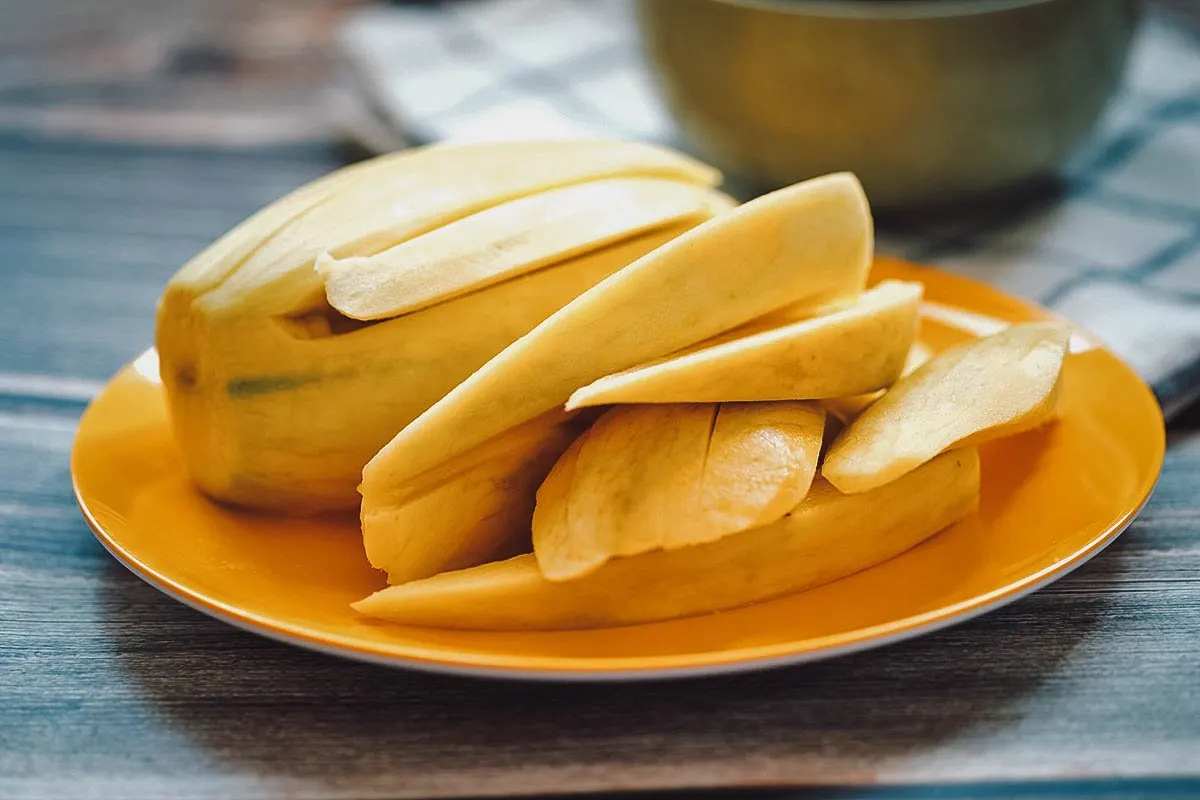
Photo by dontree
6. Taho
Like turon, taho is a classic Filipino snack. Just the mere mention of the word taho brings back happy childhood memories for many Filipinos.
Taho refers to the Filipino version of douhua, a popular Chinese snack of silken tofu that’s consumed in many parts of Asia. Douhua can be consumed in many ways but in the Philippines, it’s made with three basic ingredients – silken tofu, arnibal (brown sugar syrup), and sago (tapioca) pearls.
Taho is typically sold as street food and never made at home. It’s peddled from two large aluminum buckets strung on either side of a bamboo pole. Slung over the vendor’s shoulders, one bucket would have the silken tofu while the other carried the arnibal and sago.
Every day, either early in the morning or mid-afternoon, the vendor would comb the neighborhoods yelling “tahoooooo!” at the top of his lungs. Kids of all ages would then scramble and run to their front doors to buy a bowl or glass of their favorite Filipino merienda.
Like turon, kutsinta, and fish balls, taho is a highly nostalgic dish and definitely one of my favorite Filipino snacks.
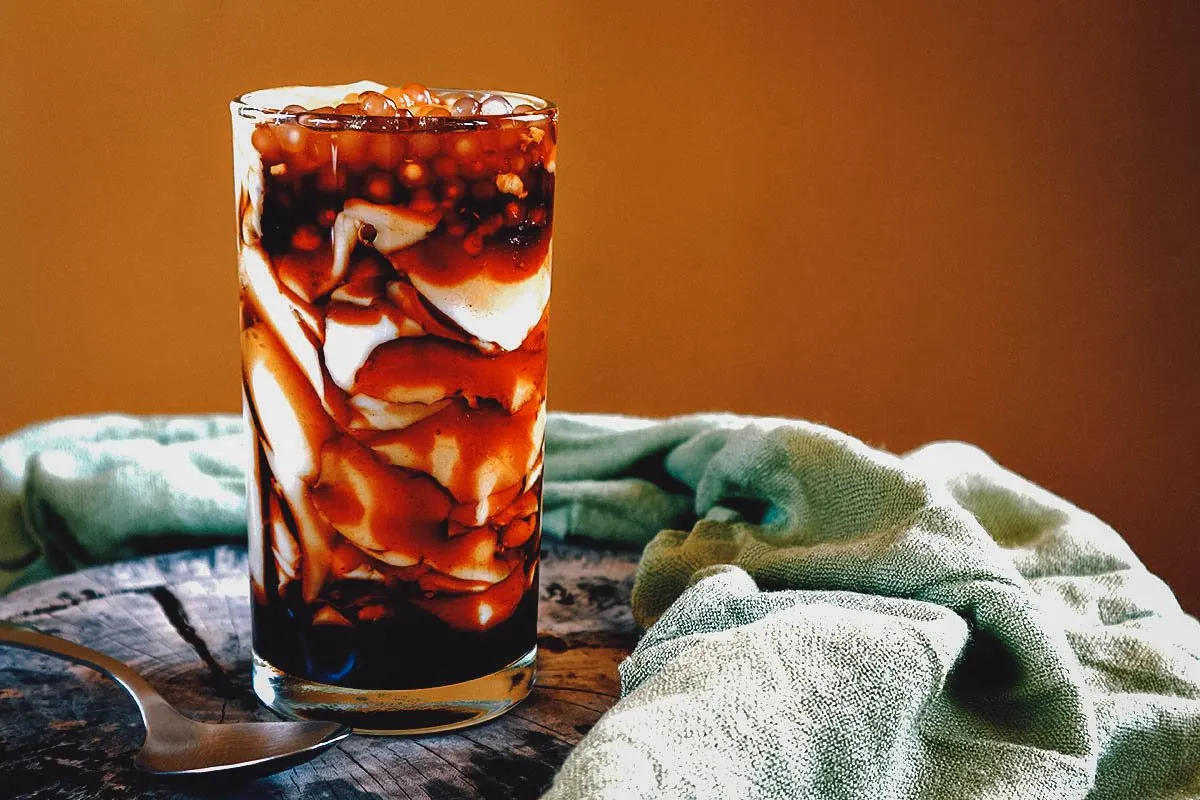
Photo by junpinzon
7. Fish Balls
Like taho and banana cue, fish balls are among the most iconic Filipino street food snacks. You can buy bags of frozen fish balls from the supermarket to make at home but the experience just isn’t the same.
Fish balls are exactly what they sound like – balls of flour mixed with some type of flaked fish meat. They’re deep-fried in oil, skewered, and then served with one of three sauces – a savory-sweet brown sauce, vinegar and chili, or a combination of the two.
Fish balls are something many Filipino kids associate with school. They’re commonly sold by mobile street vendors who’d park their carts outside elementary schools and high schools. For many kids, it was something to snack on before going home.
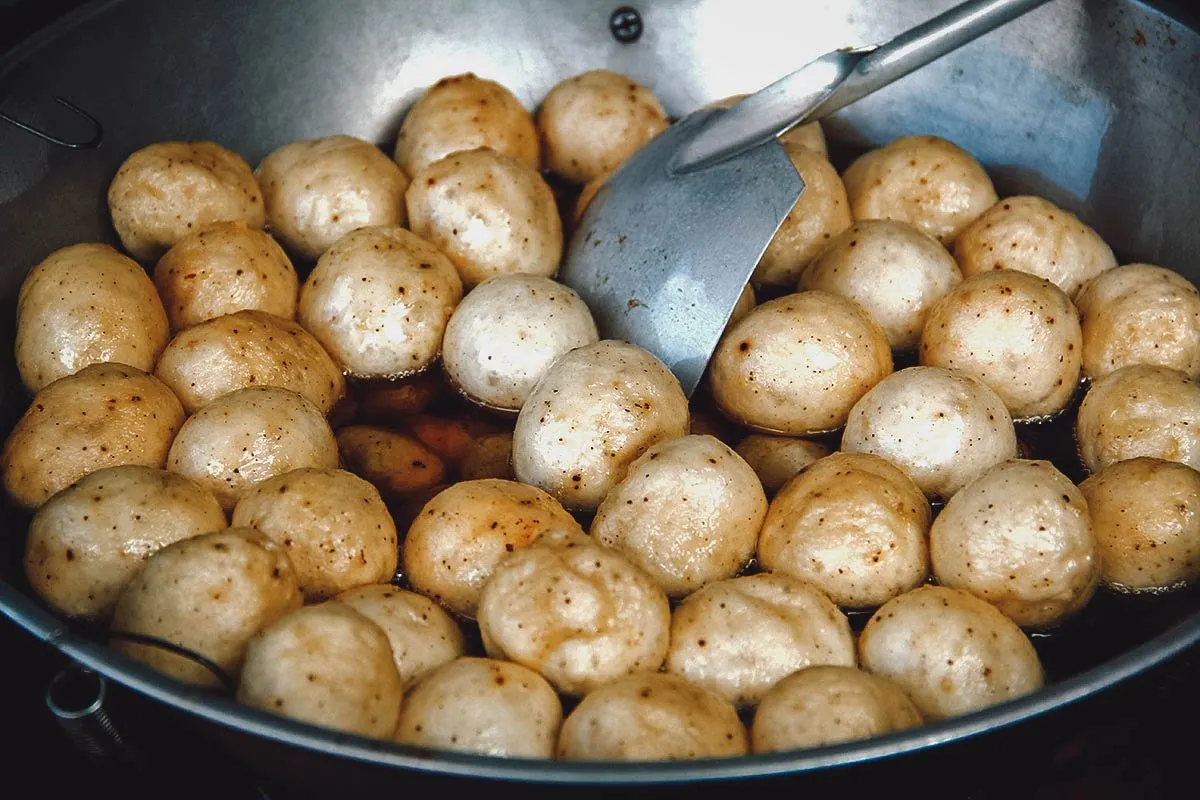
Photo by junpinzon
When I was in school, fish balls were always skewered. Today, they’re often sold from plastic cups as well.
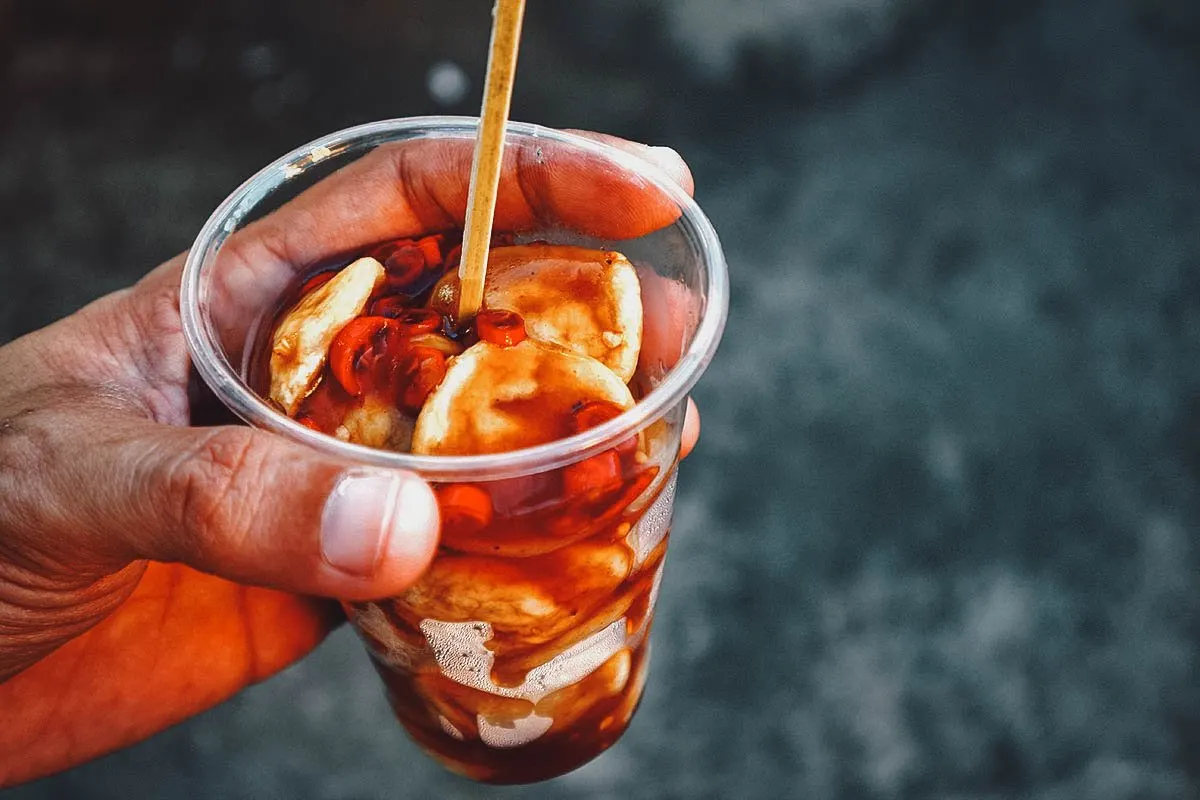
Photo by junpinzon
8. Banana Chips
Banana chips are less like merienda and more like a true snack. By that, I mean people typically snack on them at any time of the day, much like potato chips. Merienda can still qualify as a meal while saba banana chips are purely snacks.
Banana chips are sweet Filipino snacks made with thinly sliced saba bananas coated in brown sugar and then deep-fried. In some Latin American countries, they can be savory but in the Philippines, they’re always sweet.
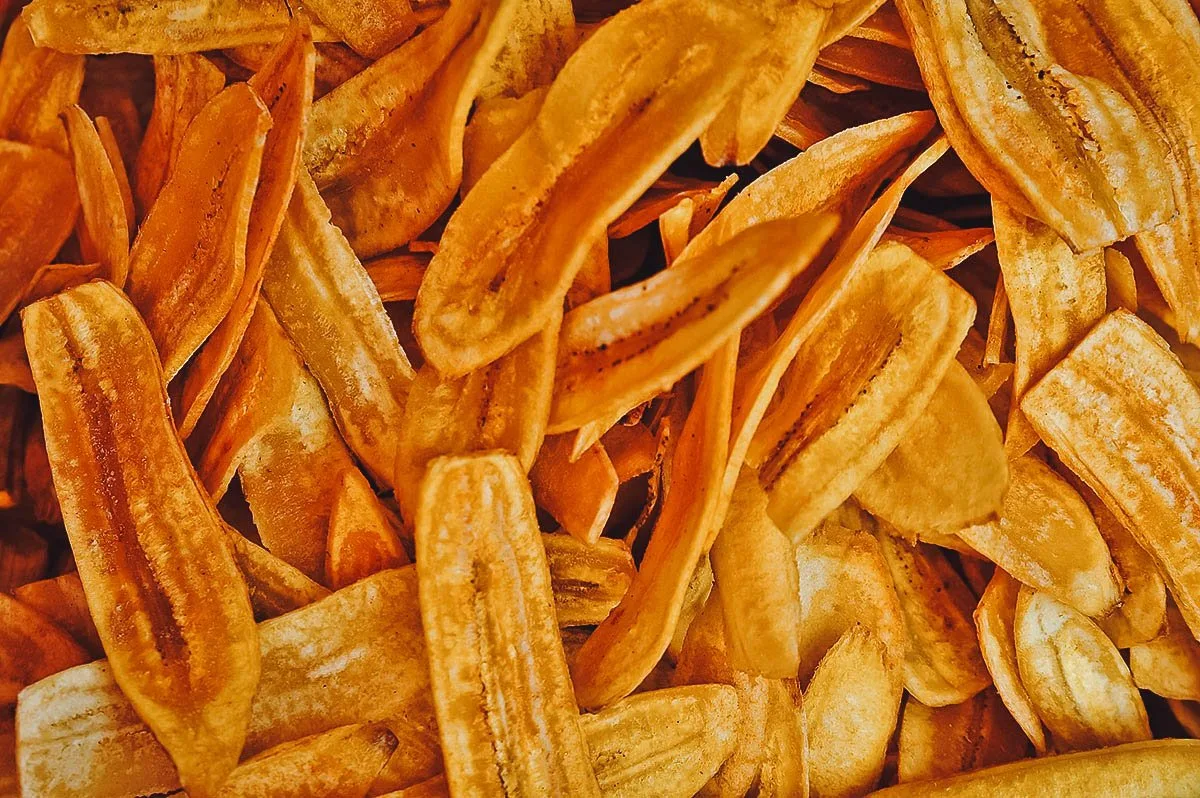
Photo by thegoatman
9. Dried Mangoes
Dried mangoes from Cebu are among the most popular Filipino souvenir food items. You’ll almost always find them at souvenir shops at any airport in the Philippines. They’re popular because they keep well, they’re easy to carry, and they’re damn delicious.
Like banana chips, dried mangoes aren’t consumed for merienda but more as a pure snack. You can even consider them to be a type of soft candy snack, similar to any dried fruit. Unlike bags of potato chips which you can finish in one sitting, people usually eat a few pieces of dried mango and then save the rest for later.
I loved dried mangoes as a kid. But compared to other Filipino snacks, they’re pretty expensive so my mom would only buy them on occasion. That made them even more desirable.
As you may know, Filipino mangoes are among the best and sweetest in the world, which is why these dried mangoes from Cebu are such a coveted tourist item.
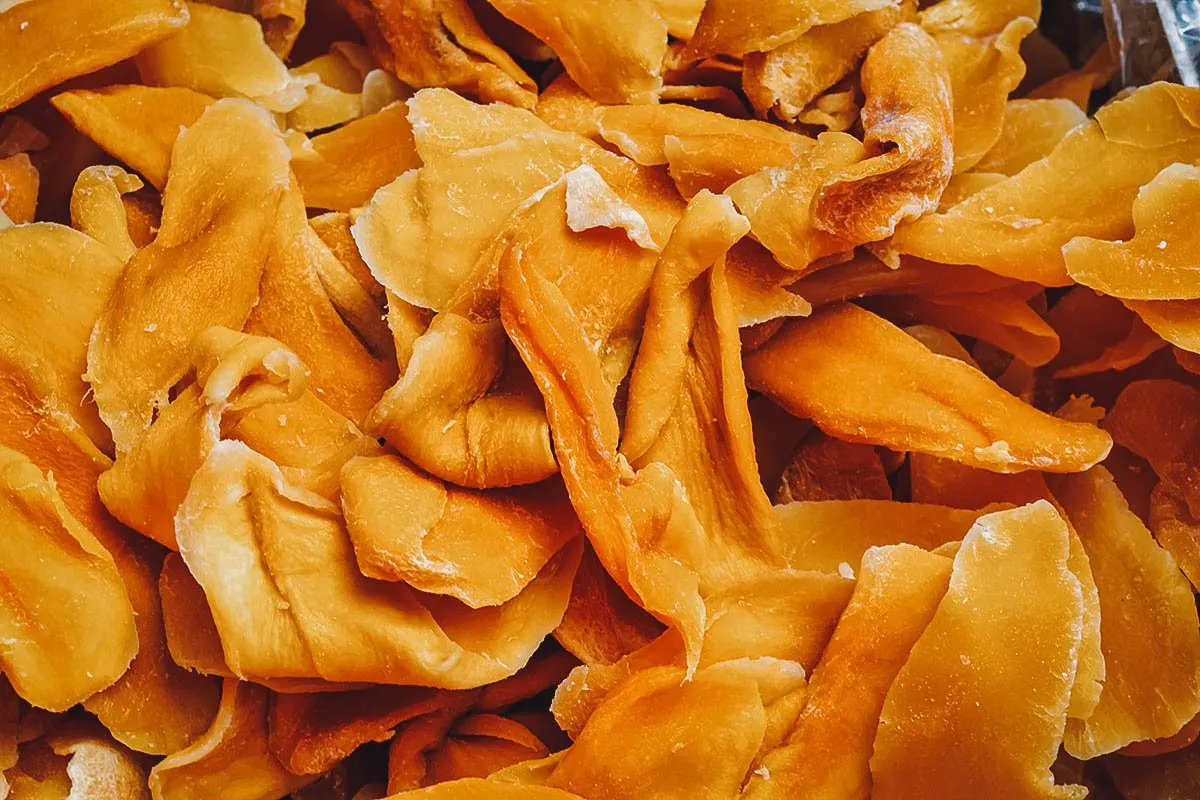
Photo by olena.sakhatska
10. Chicharon
Deep-fried pork rinds are a thing in many countries and the Philippines is no exception. These crunchy snacks made from pork skin and other animal parts are among the most popular snacks in the Philippines.
The word chicharon can refer to a family of crunchy fried snacks but the most popular type is made from pork skin (pictured below). Fried pork rinds are the most common but chicharon can be made from pork mesentery, chicken esophagus, and chicken skin as well.
Chicharon isn’t usually eaten for merienda but more as a pure snack or bar chow. Visit any Filipino bar and you’ll probably find some type of chicharon dish on the menu.
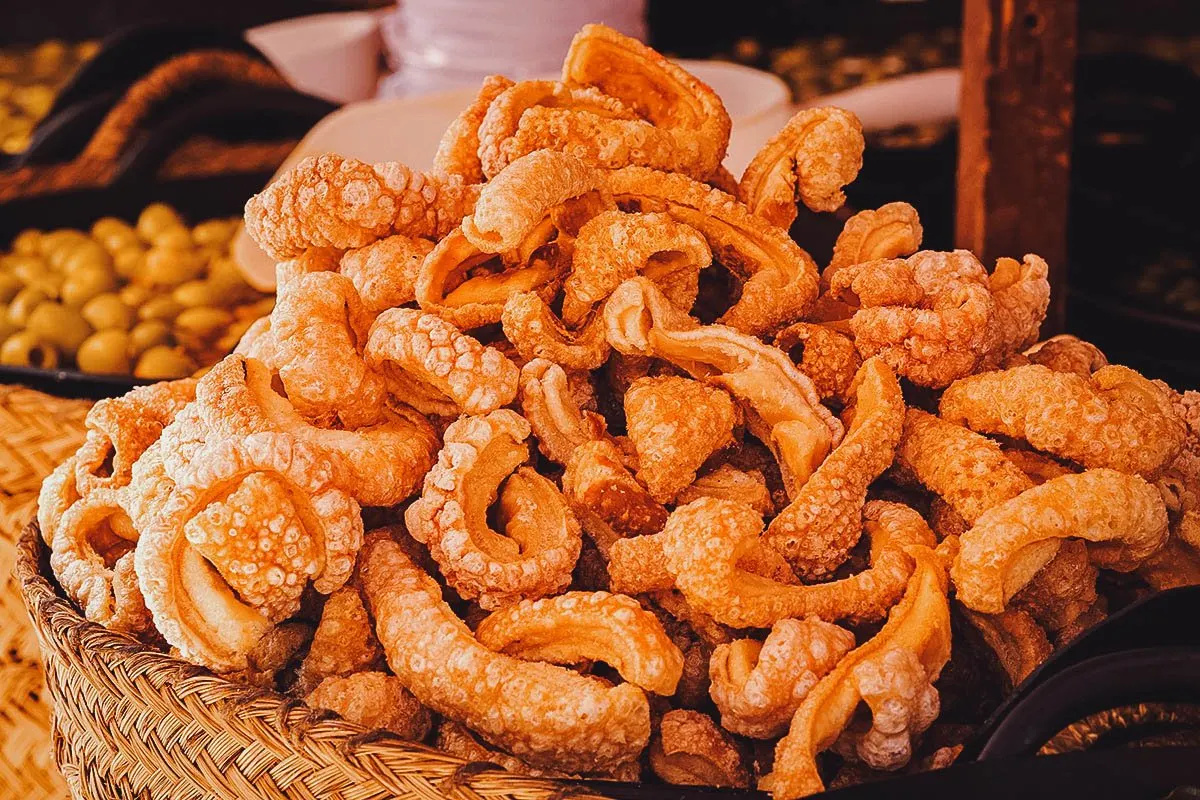
Photo by luismicss
This is hands down my favorite type of chicharon. What you’re looking at is chicharon bulaklak or chicharon made from fried pork mesentery.
Unlike other types of chicharon which are just crunchy, chicharon bulaklak is both crunchy and chewy. Bulaklak means “flower” in Filipino and refers to the frilly, flower-like shape of the mesentery.
Chicharon of any type is usually eaten with spiced vinegar to help cut the unctuousness of the fat. Not exactly one of the healthier Filipino snacks but definitely one of the most delicious.
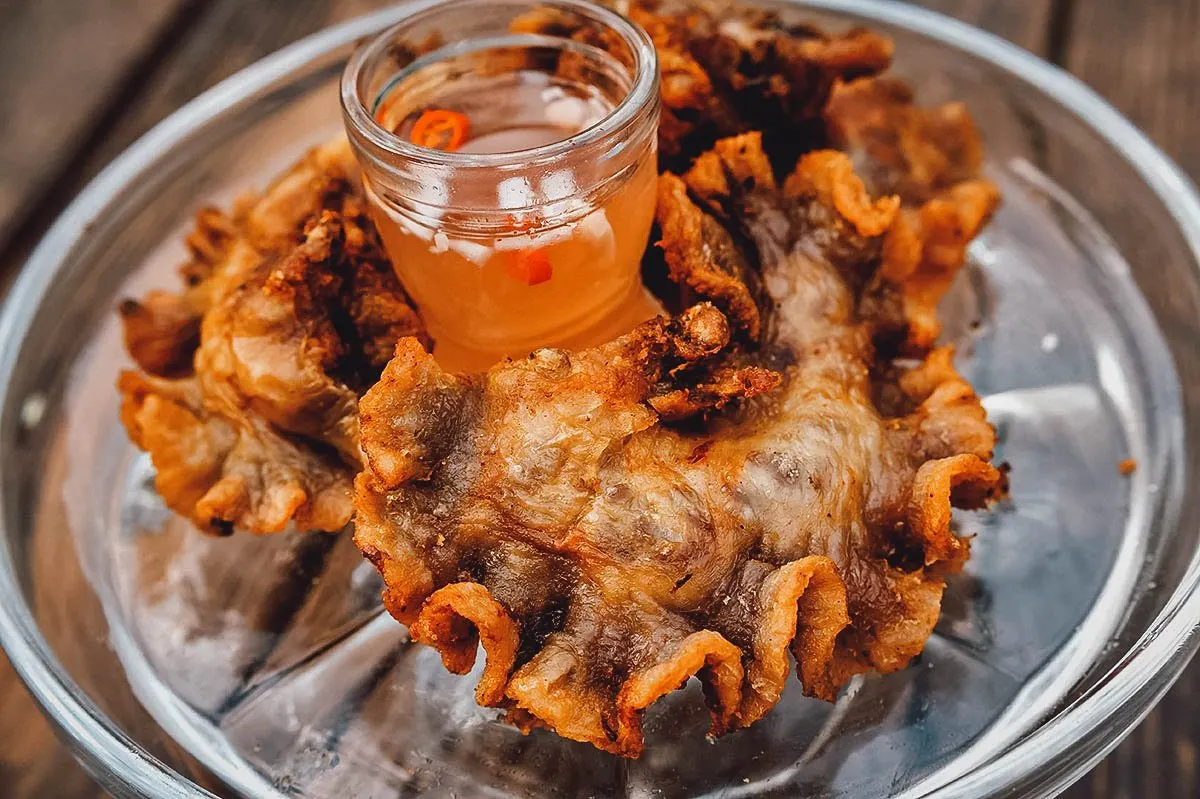
Photo by MikeEdwards
Can you guess what type of chicharon this is? I’ll give you a clue – it’s made from the biggest organ of any animal.
Fresh off the fryer below are cups of fried chicken skin. Life is short. Grab a cup.
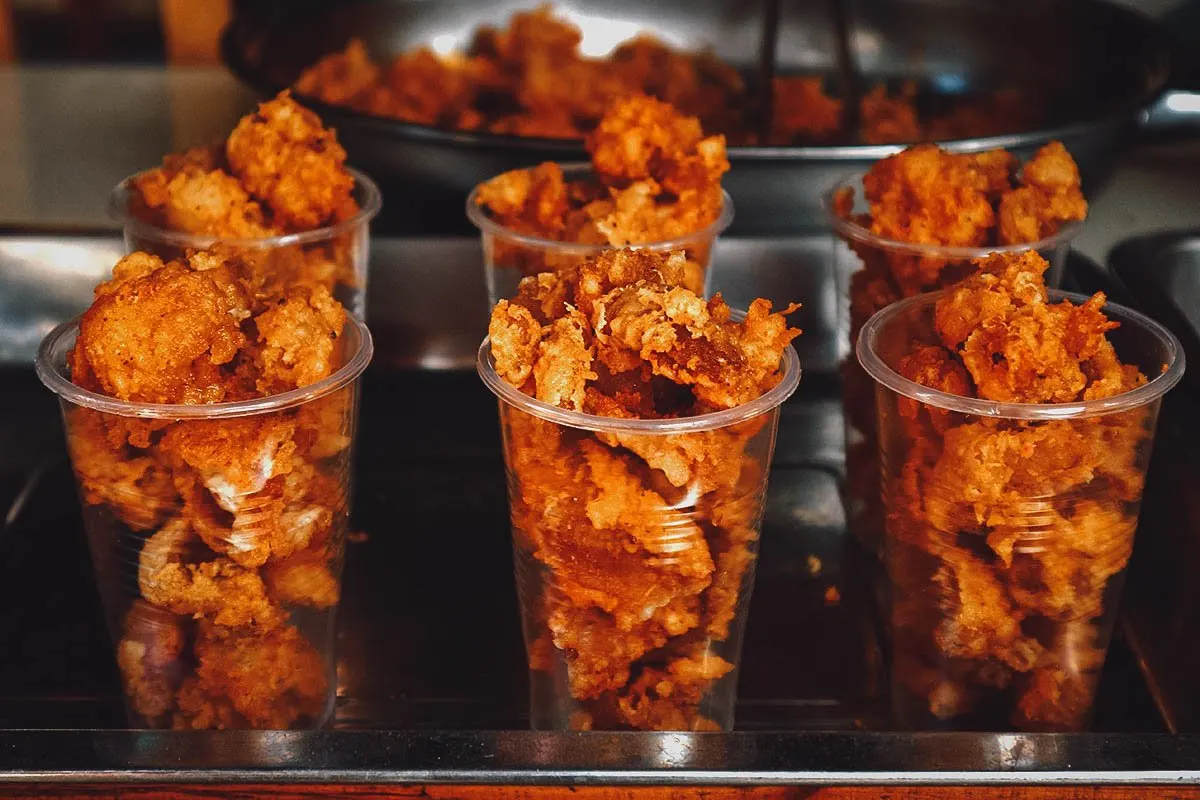
Photo by junpinzon
11. Bibingka
If you visit the Philippines during the holiday season, then you need to try bibingka. Though it’s now available year-round, it’s one of the most popular Filipino snacks associated with Christmas.
Bibingka refers to a type of rice cake made from sticky rice and coconut milk. Unlike other types of Filipino rice cake that are typically steamed, bibingka is baked in a clay pot lined with banana leaves. The pot is sandwiched between two layers of smoldering charcoal to cook the batter from the top and bottom.
Bibingka is a special holiday treat that many Filipinos look forward to around Christmas time. Like other Filipino rice cakes, it can be eaten for dessert though it’s more commonly enjoyed for merienda, usually with melted butter and grated coconut.
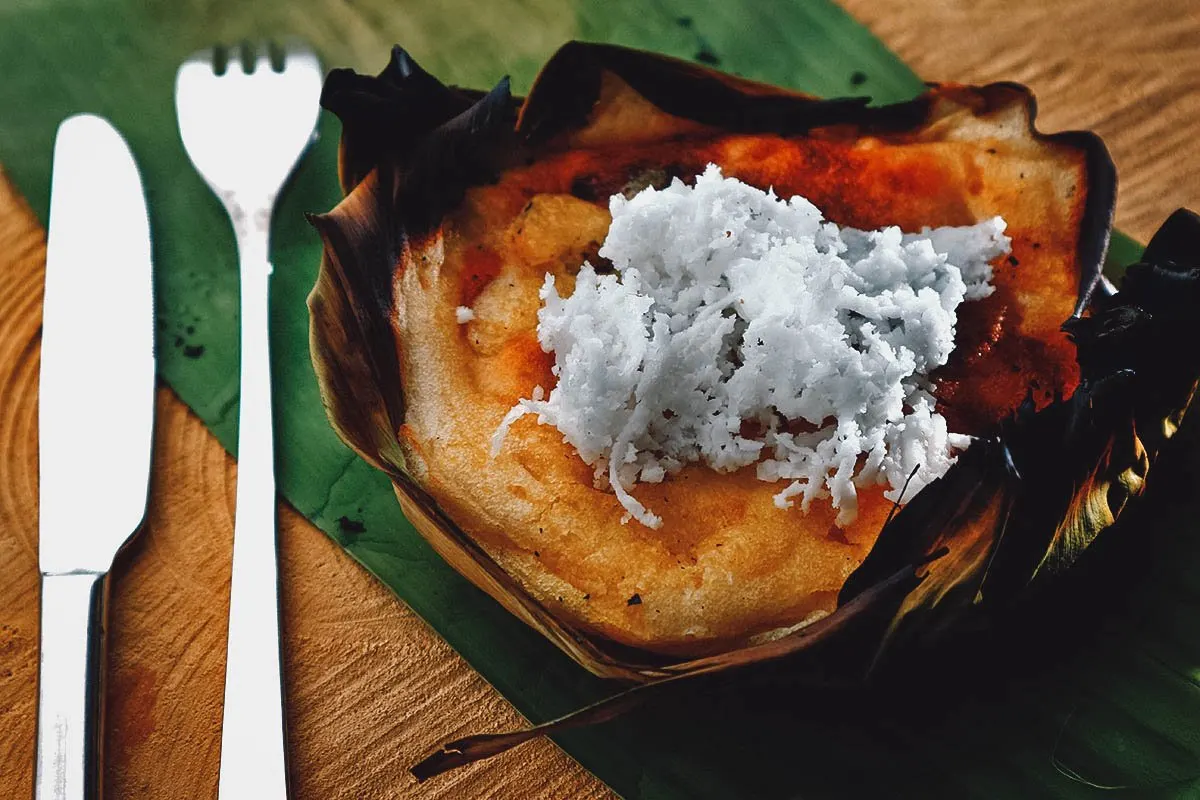
Photo by junpinzon
12. Biko
Biko is another type of Filipino sweet rice cake. Suman-like in texture, it’s a thick and dense cake made by cooking sticky rice with coconut milk and then topping it with caramelized brown sugar and coconut cream.
Biko is also referred to as bibingka malagkit (sticky bibingka), though it bears little resemblance to the previous dish.
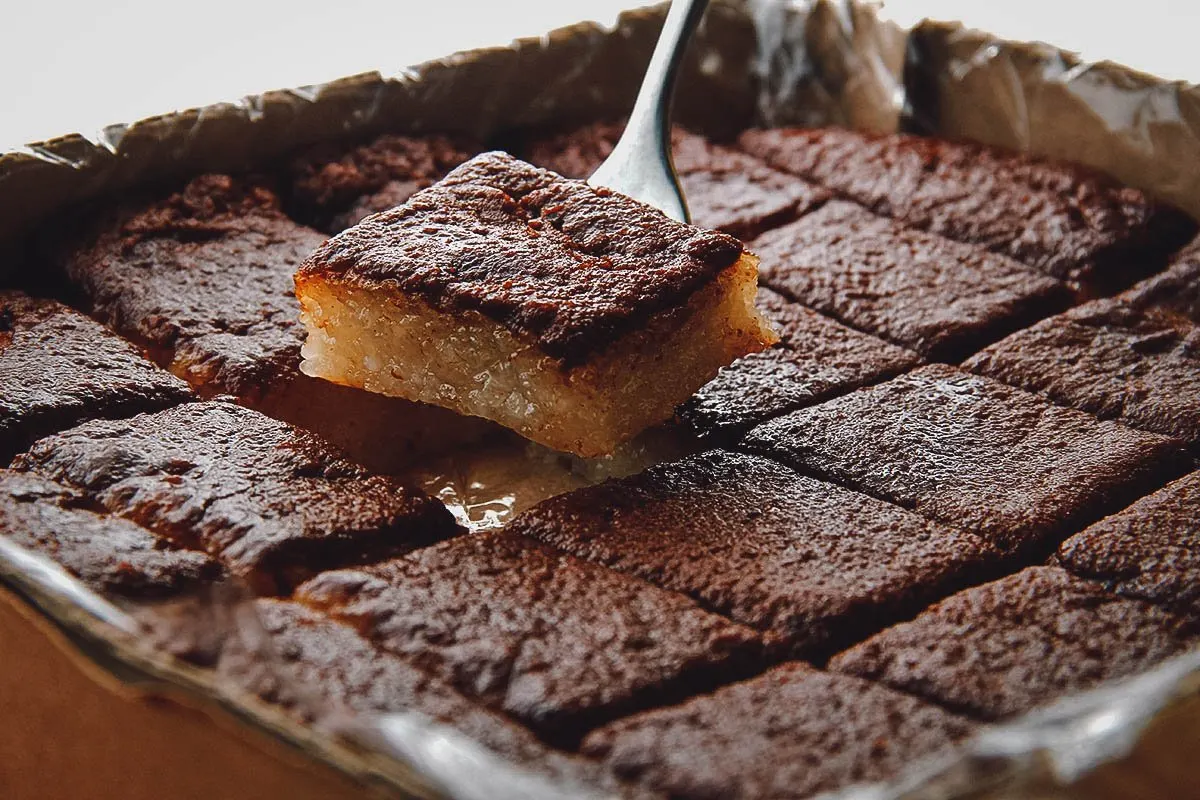
Photo by junpinzon
13. Ensaymada
Like the merienda tradition, ensaymada is a dish with Spanish roots. Originally a Mallorcan dish, it refers to a type of Filipino brioche bread baked with butter and then topped with buttercream, sugar, and grated cheese, usually queso de bola (Edam cheese).
Like bibingka, ensaymada is available throughout the year but it holds special significance during the holiday season. Food is a common Christmas gift item in the Philippines and people will often gift relatives and friends with boxes of specially-made ensaymada.
Filipino cuisine draws many influences from Spanish cooking traditions and ensaymada is one of the best examples of that.
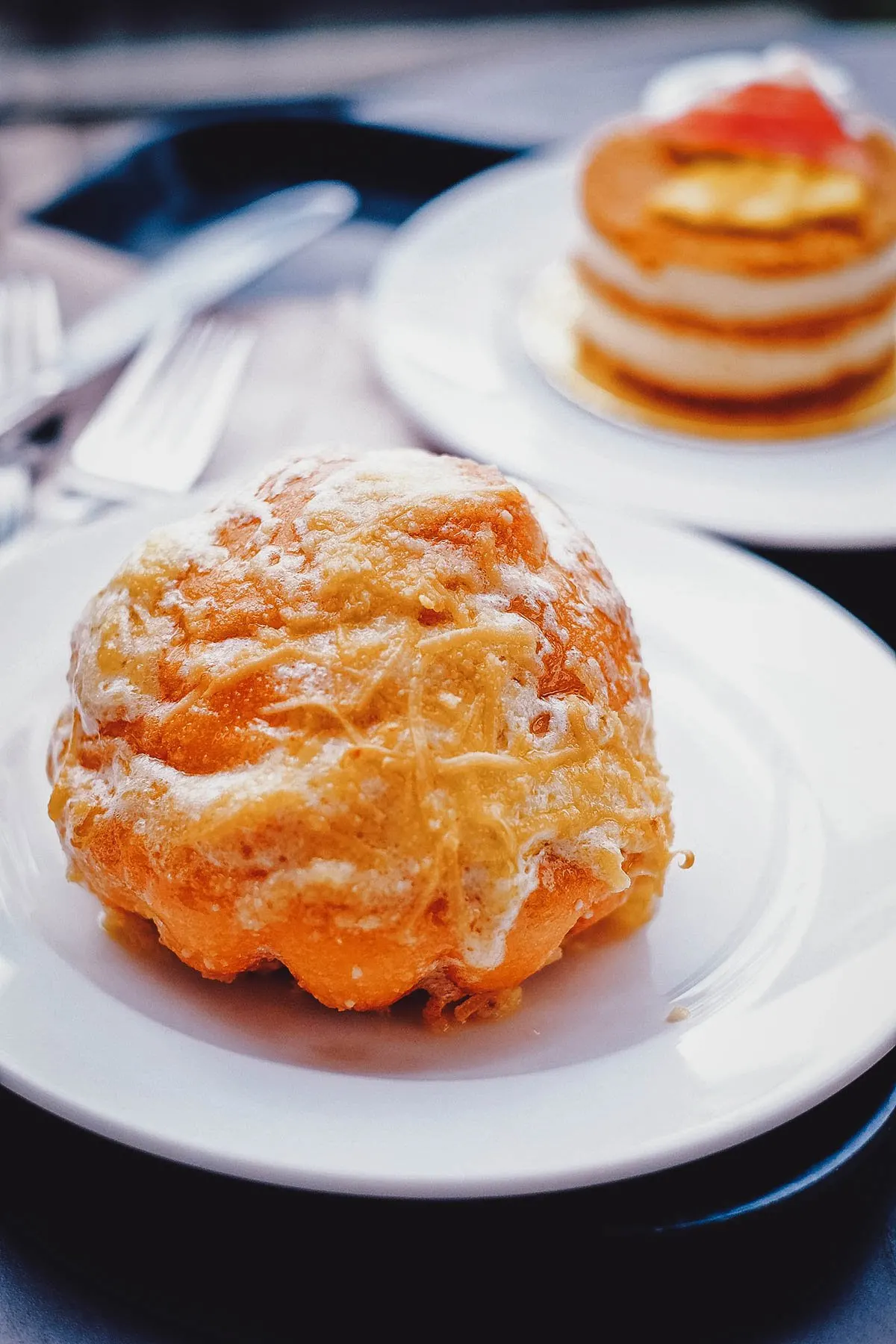
Photo by nuitgarden
14. Empanada
The empanada is another dish that was brought to the Philippines by the Spanish. Common throughout Latin America, it refers to a half-moon-shaped baked or fried pastry stuffed with ground meat, potatoes, carrots, onions, and raisins.
Filipino empanadas are usually small in size, about the length of your palm. People often eat two or three of these for merienda.
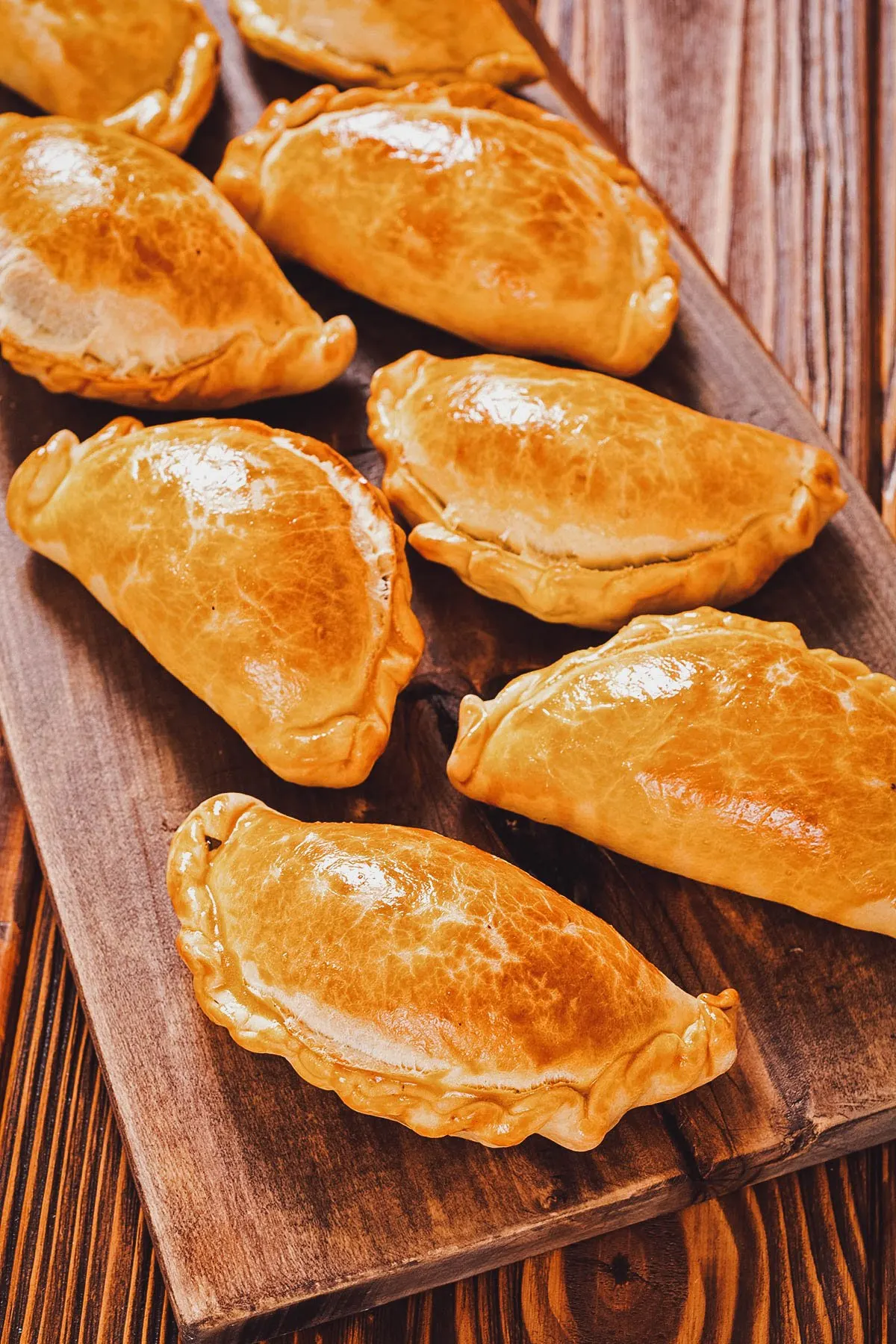
Photo by whitestorm4
One of the most famous types of Filipino empanada is from Vigan, a city in northern Luzon famous for its regional cuisine. It’s a larger type of empanada – about the size of an American taco – and is more orange in color due to the use of annatto seeds in the batter.
Vigan empanada also differs in its filling. It’s stuffed with grated green papaya, mung bean sprouts, shredded carrots, hard-boiled egg, and skinless Vigan longganisa. Just one of these bad boys will definitely be enough for merienda.
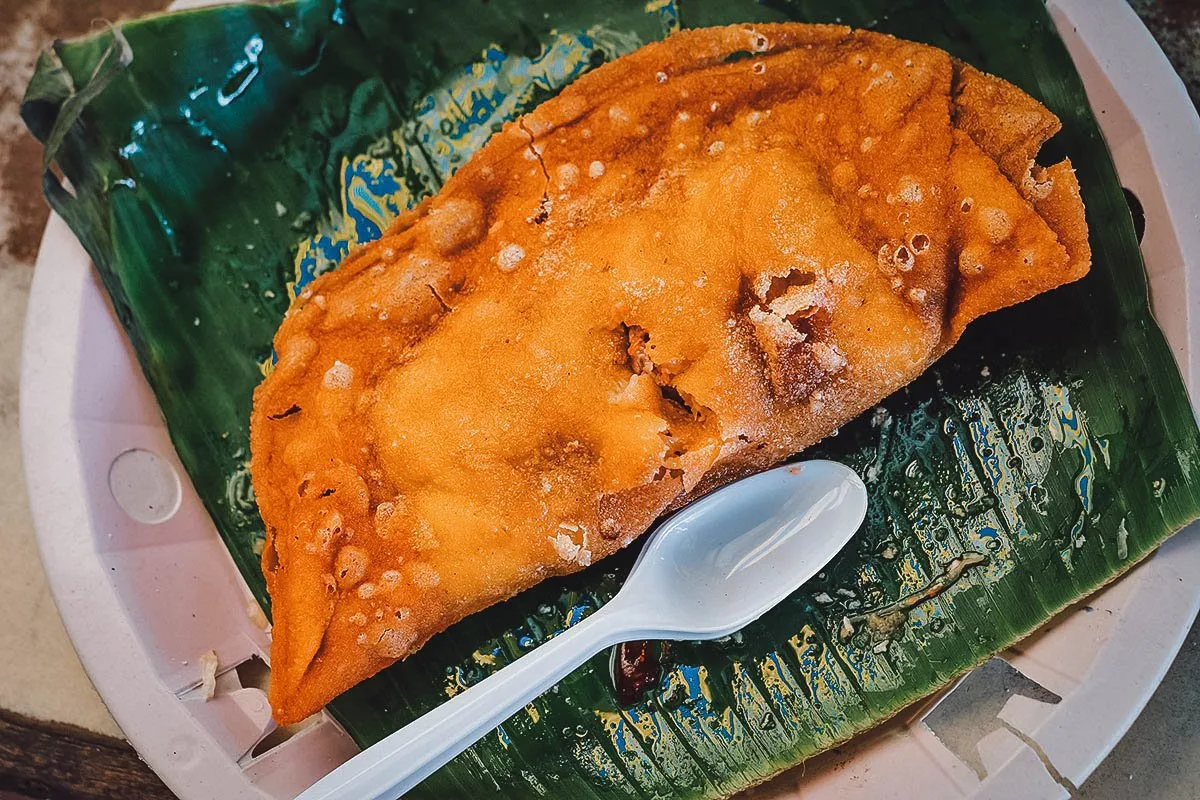
Photo by MikeEdwards
15. Balut
Last on this list is that infamous and bizarre Filipino snack known as balut. If you’ve never heard of it, balut refers to an unfertilized duck egg embryo that’s been incubated for 2-3 weeks, boiled, and then eaten directly from its shell.
What makes balut so controversial and off-putting for many, including some Filipinos, is that the fetus is often developed enough to be recognizable. You can see the beak, eyes, wings, and early formation of feathers. It’s definitely the most challenging snack on this list and not something everyone has the stomach for.
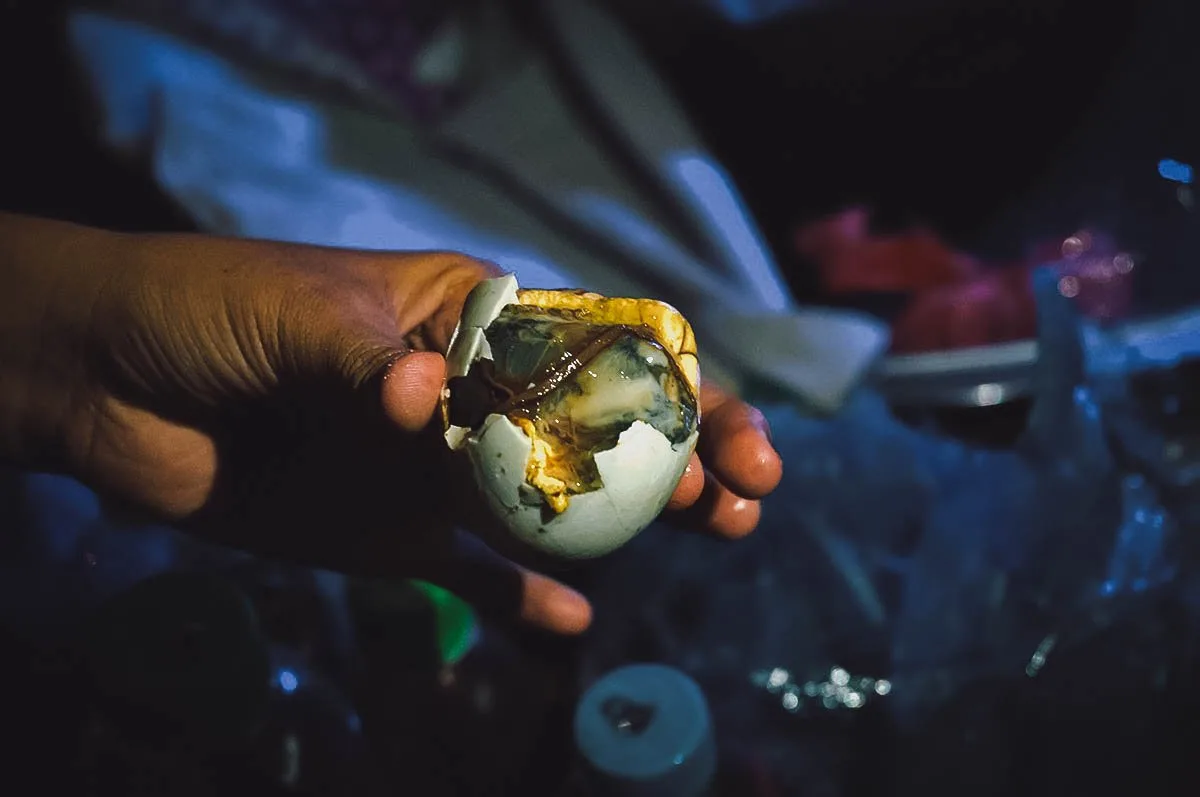
Photo by [email protected]
FINAL THOUGHTS ON FILIPINO SNACKS
When considering which dishes to include in this list of the best Filipino snacks, I thought about adding things like lumpia, Japanese sweet corn, and halo-halo.
I didn’t wind up adding lumpia because it’s eaten mainly as an appetizer while halo-halo is typically consumed for dessert. Japanese sweet corn, often sold as street food, makes more sense and would probably be the 16th entry on this list. Ginataang bilo-bilo would be a good addition too.
Though Filipinos are equally fond of commercially processed snacks like Clover Chips, Jack n’ Jill Chippy, Boy Bawang, and Tomi Sweet Corn Chips, I consider them to be junk food and not something you’d put on the same list as puto or suman.
In the Philippines, we call those types of snacks chichirya (junk food). Filipinos have quite a fondness for junk food so I may write a separate article on chichirya and Filipino candies like Choc Nut (peanut-flavored milk chocolate candy) as well.
Until then, I hope you enjoyed reading this article on the most popular Filipino snacks. If you have any favorite merienda dishes to add, then please let us know in the comment section below. Salamat!
Cover photo by asimojet. Stock images via Depositphotos.


minnie
Wednesday 23rd of November 2022
ginatan??? (...bilo-bilo, ...maiz, ...mungo)
Reymond
Wednesday 19th of October 2022
Kapampangan Top Merienda 1. Okoy 2. Pansit Palabok 3. Halo Halo 4. Sampelot 5. Putong Babi 6. Kitsan Mais, laga at Ningnang Mais native 7. Bibingka 8. Kape 9. Kakanin Biko, kapit, Kasava 10. Tidtad 11. Putong Babi 12. Turon, kamote Saging Saba 13. Tinape Monay Donut 14. Lelut Mais Lelut Balatung 15. Puto't kutsinta
JB & Renée
Friday 21st of October 2022
Best comment ever. Thank you Reymond!
Carol barcel
Tuesday 4th of October 2022
Yes you forgot to mention cassava cake, I love all you mention.
Winnie VM
Saturday 10th of September 2022
You forgot to mention,cassava cake and Leche plan.Are they not considered common Filipino snacks?
JB & Renée
Wednesday 14th of September 2022
Cassava cake yes. I personally consider leche flan to be more of a dessert, but to each his own.
Marty Sanders
Tuesday 6th of September 2022
Turon and banana cue (or Q) typically do not use true plantain. We use saba bananas, a cultivar that originated from the Philippines. Saba is a cooking banana. It is not the same as plantain.
JB & Renée
Wednesday 7th of September 2022
I'm a Filipino Marty, I know. :) I used "plantain" for simplicity's sake but yes, it's perhaps better to be more specific.